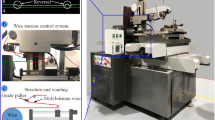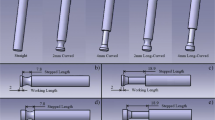Abstract
Electrode jump motion is applied to most of the electrical discharge machining (EDM) machine to remove debris from machining gap. The time consumption of one consecutive-pulse discharge process between two adjacent electrode jump motions is named electrode machining time. If the two parameters can be timely adjusted to the optimal values during machining, the efficiency will be obviously improved. However, the complicated flow field of the machining gap that contains kerosene, debris, and bubbles makes it difficult to determine the optimal values of electrode machining time and jump height. This research proposes a strategy to solve this problem. By detecting the voltage and current signals between electrode and workpiece, the normal discharge frequency and abnormal discharge ratio were calculated to determine the optimal electrode machining time. Then, the optimal electrode jump height was calculated through a model which simulates the gap flow field in EDM. Experimental results show that the proposing strategy evidently improves the EDM efficiency.














Similar content being viewed by others
References
Suda T, Sata T (1974) Movement of conductive particles in EDM gap. J JSEME 7(14):19–28
Schumacher BM (1990) About the role of debris in the gap during electrical discharge machining. CIRP Ann Manuf Technol 39(1):197–199
Bommeli B, Frei C, Ratajski A (1979) On the influence of mechanical perturbation on the breakdown of a liquid dielectric. J Electrostat 7:123–144
Kunieda M, Yanatori K (1997) Study on debris movement in EDM gap. IJEM 2:43–49
Kunieda M, Kojima H, Kinoshita N (1990) On-line detection of EDM spark locations by multiple connection of branched electric wires. CIRP Ann Manuf Technol 39(1):171–174
Uhlmann E, Domingos DC (2013) Investigations on vibration-assisted EDM-machining of seal slots in high-temperature resistant materials for turbine components. Procedia CIRP 6:71–76
Uhlmann E, Domingos DC (2016) Investigations on vibration-assisted EDM-machining of seal slots in high-temperature resistant materials for turbine components—Part II. Procedia Cirp 42:334–339
Albert WJH, Chung CH (2010) Effective pulses discriminator and direct-drive jump control for high efficiency electrical discharge machining (EDM) processes. In: Proceedings of the 16th International Symposium on Electromachining (ISEM XVI), Shanghai, China, April 2010, pp 175–180
Wang WM, Rajurkar KP, Akamatsu K (1995) Digital gap monitor and adaptive integral control for auto-jumping in EDM. J Eng Ind 117(2):253–258
Zhou M, Han F (2009) Adaptive control for EDM process with a self-tuning regulator. Int J Mach Tools Manuf 49(6):462–469
Zhao WS, Masuzawa T (1990) Adaptive control of EDM-jump with self-tuning approach. B Jpn Soc Pre Eng 24(1):45–50
Wu JY, Zhou M, Xu XY, Yang JW, Zeng XW, Xu DH (2016) Fast and stable electrical discharge machining (EDM). Mech Syst Signal Process 72–73:420–431
Morita A, Imai Y, Maruyama H, Kobayashi K (1989) Fuzzy controller for EDM. In: Proceedings of 9th international symposium for electro-machining (ISEM IX), Nagoya, Japan, April 1989, pp 236–239
Kobayashi K (1995) The present and future developments of EDM and ECM. In: Proceedings of 11th international symposium for electro-machining (ISEM XI), Lausanne, Switzerland, pp 29–47
Boccadoro KPM, Dauw DF (1995) About the application of fuzzy controllers in high-performance die-sinking EDM machines. Ann CIRP 44(1):147–150
Wang J, Han FZ, Zhao FL (2012) Improvement of EDM efficiency with a new adaptive control strategy. Int J Adv Manuf Technol 62(9–12):1025–1040
Cetin S, Okada A, Uno Y (2004) Effect of debris distribution on wall concavity in deep-hole EDM. JSME Int J Ser C 47(2):553–559
Han F, Zhang J, Cheng G, Takahito I (2010) Modeling of workpiece removal rate on EDM. In: Proceedings of the 16th international symposium on electromachining (ISEM XVI), Shanghai, China, pp 101–104
Gadeschi GB, Schneider S, Mohammadnejad M, Meinke M, Klink A, Schröder W. Klocke F (2017) Numerical analysis of flushing-induced thermal cooling including debris transport in electrical discharge machining (EDM). Procedia Cirp 58:116–121
Pontelandolfo P, Haas P, Perez R (2013) Particle hydrodynamics of the electrical discharge machining process. In: Proceeding of the seventeenth CIRP conference on electro physical and chemical machining (ISEM XVII), Leuven, Belgium, pp 47–52
Zhou M, Han F (2009) Assessment of the dynamical properties in EDM process—detecting deterministic nonlinearity of EDM process. Int J Adv Manuf Technol 44(1, 2):91–99
Serkan C, Akira O, Yoshiyuki U (2003) Electrode jump motion in linear motor equipped die-sinking EDM. JSME Int J Ser C 125:809–815
Havakawa S, Itoigawa TDF, Nakamura T (2010) Observation of flying debris scattered from discharge point in EDM process. In: International symposium on electromachining, pp 121–125
Ikeda M (1972) The movement of a bubble in the gap depending on the single electrical discharge. Jpn Soc Electr Mach Eng 6(11):12–15
Kusano T, Yoshida M, Kunieda M (1993) Process monitoring of EDM by measuring volume of gas generated in discharge gap. In: Proceedings of 1993 annual meeting of JSEME, pp 87–90
Yoshida M, Kunieda M (1998) Study on the distribution of scattered debris generated by a single pulse discharge in EDM process. Int J Electr Mach 3:39–46
Klocke F, Zeis M, Heidemanns L (2018) Fluid structure interaction of thin graphite electrodes during flushing movements in sinking electrical discharge machining. CIRP J Manuf Sci Technol 20:23–28
Acknowledgements
This work is supported by Beijing Municipal Natural Science Foundation (3162020) and National Natural Science Foundation of China (51505027).
Author information
Authors and Affiliations
Corresponding author
Rights and permissions
About this article
Cite this article
Wang, J., Jia, Z. Efficiency improvement in electrical discharge machining (EDM) of constant section cavity based on experimental study and numerical calculations. Prod. Eng. Res. Devel. 12, 567–578 (2018). https://doi.org/10.1007/s11740-018-0835-y
Received:
Accepted:
Published:
Issue Date:
DOI: https://doi.org/10.1007/s11740-018-0835-y




